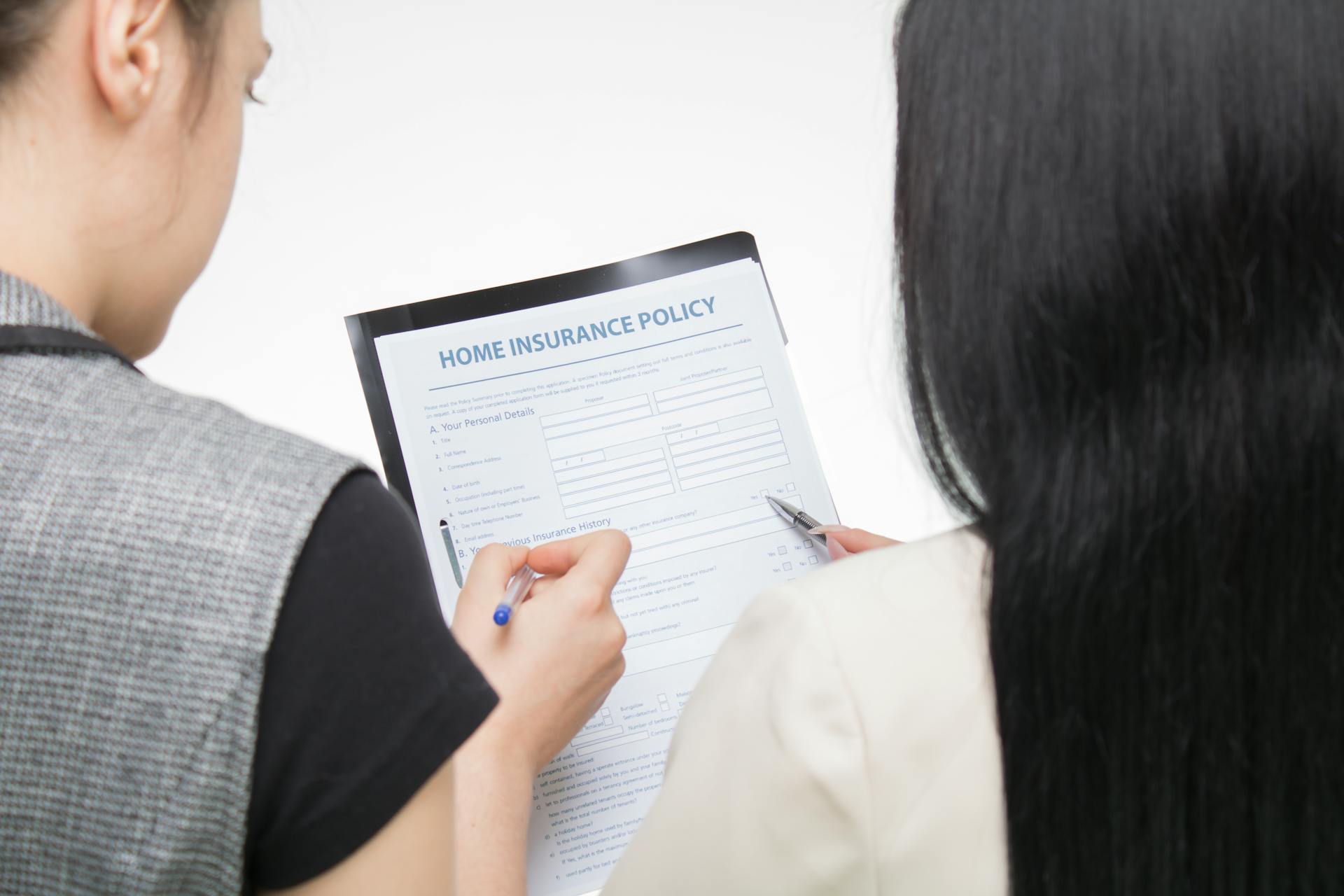
Term life insurance can seem like a mystery, but understanding the basics can help you make an informed decision. The cost of term life insurance varies depending on your age, health, and the amount of coverage you choose.
A 35-year-old non-smoker can expect to pay around $15 to $30 per month for a 20-year term life insurance policy with a $250,000 coverage amount.
The cost of term life insurance increases with age, with a 45-year-old non-smoker paying around $30 to $60 per month for the same policy.
You might enjoy: Life Insurance and Non Life Insurance
What Is Term Life Insurance?
Term life insurance is a type of life insurance that provides coverage for a specified period, typically ranging from 10 to 30 years.
This coverage period is chosen by the policyholder, and it's usually based on their financial obligations, such as paying off a mortgage or raising children.
The policy pays a death benefit to the beneficiary if the policyholder dies during the coverage period, but the policy expires if the policyholder outlives the term.

Policyholders can choose from various term lengths, including 10, 15, 20, and 30 years, each with its own premium cost.
The cost of term life insurance is directly tied to the policy's term length, with longer terms typically being more expensive.
Some policies offer renewable options, allowing policyholders to extend their coverage at the end of the term without having to reapply or undergo medical exams.
This can provide peace of mind for policyholders who want to maintain coverage without worrying about future health issues affecting their eligibility.
How It Works
A term life insurance policy is an agreement between you and a life insurance company, where you pay a premium for a specific period of time in exchange for a guaranteed death benefit.
The insurance company evaluates your health, lifestyle, and other factors to determine your risk level during the underwriting process, which typically involves a medical exam and a review of your medical history.
For more insights, see: Mutual of Omaha Term Life Insurance No Medical Exam

You can designate primary and contingent beneficiaries, with the primary beneficiary receiving the death benefit first and the contingent beneficiary receiving it if the primary cannot.
If you die during the policy term, the insurer will pay the policy's face value to your beneficiaries, which may be used to settle your healthcare and funeral costs, consumer debt, mortgage debt, and other expenses.
The death benefit is almost always paid out in an income tax-free lump sum of cash, and beneficiaries are not required to use the insurance proceeds to settle the deceased's debts.
You may be able to renew a term policy at expiration, but the premiums will be recalculated based on your age at the time of renewal.
The process of buying a term life insurance policy involves determining the premium based on the policy's value and factors such as age, gender, and health.
A term life insurance policy has no cash value component, so once the life insurance term is over, there's no value or payout to your family.
You can name more than one beneficiary and specify the percentage of the death benefit each should receive, but you must ensure the total adds up to 100 percent.
Here's an interesting read: Do Term Life Policies Have Cash Value
Types of Term Life Insurance Policies

Term life insurance policies come in various forms, each designed to meet specific needs. Level term life insurance is the most common type, offering fixed premiums and a fixed death benefit for a set period, usually between 10 to 30 years.
The cost of level term life insurance varies depending on the term length, with longer terms typically costing more. For example, a 30-year term might be more expensive than a 10-year term.
Decreasing term life insurance is designed to cover debts that decrease over time, such as a mortgage. This type of insurance has a lower cost compared to level term life insurance because the death benefit decreases over the term.
Renewable term life insurance allows you to renew your policy without needing a new medical exam, but premiums may increase with each renewal. This type of insurance is often referred to as yearly renewable term insurance.
Convertible term life insurance lets you convert your term policy into a permanent life insurance policy without needing a new medical exam. This option allows you to secure lifelong coverage if your needs change.
Explore further: Accelerated Death Benefit Term Life Insurance

Return of premium term life insurance includes a feature where, if you outlive the term of the policy, you get back the premiums you paid. This type of policy has higher premiums compared to regular term life insurance, but it provides the added benefit of a refund if no death benefit is paid out.
Here's a brief summary of the major types of term life insurance policies:
- Level term life insurance: Offers fixed premiums and a fixed death benefit for a set period.
- Decreasing term life insurance: Designed to cover debts that decrease over time.
- Renewable term life insurance: Allows you to renew your policy without needing a new medical exam.
- Convertible term life insurance: Lets you convert your term policy into a permanent life insurance policy.
- Return of premium term life insurance: Includes a feature where you get back the premiums you paid if you outlive the term of the policy.
Benefits and Features
Term life insurance is attractive to young people with children because it provides substantial coverage at a low cost.
Parents can rely on the death benefit to replace lost income if the insured dies while the policy is in effect.
Term life insurance is well-suited for people with growing families, allowing them to maintain coverage until their children reach adulthood.
The term life benefit can be equally useful to an older surviving spouse, helping them cover expenses.
However, premiums for people who apply for insurance later in life will be higher than if they'd gotten a level-term policy when they were younger.
Insurance companies typically set a maximum age for term life insurance coverage, usually ranging from 80 to 90 years old.
Related reading: Family Income Benefit Term Life Insurance
Cost and Premiums

Term life insurance is often chosen for its low cost and substantial coverage.
Premiums for term life policies increase with age, so it's usually more affordable to get a policy when you're younger.
The cost of premiums is primarily based on mortality tables, with higher risk policyholders receiving higher rates.
Your age, gender, health issues, smoking status, policy type, and coverage amount all impact your premium rates.
Women typically have lower premiums due to their longer life expectancies.
Smoking status is a significant factor, with non-smokers paying significantly lower premiums.
The type of life insurance you choose, such as term life or permanent life, affects the cost of your insurance.
Here are the average annual rates for term life vs. whole life policies:
The cost of premiums increases with age, so it's essential to consider your age when choosing a policy.
Additional reading: Best Age to Get Term Life Insurance
Choosing and Buying a Policy
If you only need coverage for a specific period of time, such as raising children or paying off your mortgage, term life insurance is a great option. This type of insurance can replace your income if you pass away during this time.

Term life insurance is also the most affordable option, especially if you're young and healthy. You can save money by buying a cheaper term life policy and investing the difference elsewhere.
Consider purchasing life insurance as soon as possible to lock in lower premium rates. The sooner you get coverage, the less you'll pay each month.
To qualify for lower premiums, maintain a healthy lifestyle by managing any pre-existing health conditions, quitting smoking, eating a healthy diet, and exercising regularly.
Here are some key factors to consider when choosing a term life insurance policy:
- Only want coverage for a specific period of time
- Want the most affordable coverage
- Think you might want permanent life insurance but can’t afford it right now
- Don’t want to use life insurance to accumulate a cash value
Availability of Coverage
Having a clear understanding of the availability of coverage is crucial when choosing a life insurance policy.
Term policies that are not guaranteed renewable can be cancelled by the company at the end of the term if the policyholder develops a severe illness.
Permanent insurance provides coverage for life as long as premiums are paid, regardless of changes in the insured's health.
Determining Coverage Needs

You're probably wondering how much insurance you actually need. The answer depends on your age and how many family members rely on your income.
Younger people typically need more coverage to compensate for the years of potential wage-earning ahead of them.
The Human Life Value method is a rough estimation method that multiplies your current income by 30 if you're between 18 and 40.
As you get older, you'll have fewer working years left, so the multiple decreases.
For example, if you're 40, you might multiply your current income by 20, and by 15 if you're 50.
Intriguing read: 40 Year Term Life Insurance Rates
Riders
Riders can be a valuable addition to your term life insurance policy, filling in gaps in coverage and providing extra financial protection for your loved ones. A child term rider provides a small payout for eligible children, covering them from as young as 14 days old until they reach a specified age, usually 18 or 25.

If you don't pass away within the policy's term, a return of premium rider ensures you receive back the money you paid into the policy. This can be a great option for those who want to ensure their investment doesn't go to waste.
A waiver of premium rider can pause your monthly premium if you become critically ill, injured, or disabled and cannot go to work. However, qualifying scenarios are determined by the particular insurer, and coverage typically ends at a certain age, usually 65.
Some riders, like the accelerated death benefit rider, allow you to access a portion of your death benefit while you're still alive if you're diagnosed with a terminal illness. This can help cover medical expenses and other costs associated with a terminal illness.
Here are some common riders available for term life insurance:
- Child term rider: Covers children from 14 days old to a specified age (usually 18 or 25)
- Return of premium rider: Returns your premium if you don't pass away within the policy's term
- Waiver of premium rider: Pauses your premium if you become critically ill, injured, or disabled
- Accelerated death benefit rider: Allows access to a portion of your death benefit for terminal illnesses
- Accidental death benefit rider: Provides an additional payout for accidental death
- Chronic illness rider: Allows access to a portion of your death benefit for chronic illnesses
How to Buy
To buy a policy, start by researching different insurance companies and their policies, as mentioned in the "Understanding Insurance Companies" section. This will help you compare prices and coverage options.

Look for policies that offer a range of coverage options, such as liability, collision, and comprehensive coverage, as discussed in the "Types of Coverage" section. This will ensure you're adequately protected in case of an accident or other incident.
Consider your budget and financial situation, as highlighted in the "Factors to Consider" section. You'll want to choose a policy that fits within your means and provides the right level of coverage for your needs.
Don't be afraid to ask questions or seek advice from a licensed insurance professional, as mentioned in the "Working with an Insurance Agent" section. They can help you navigate the process and find the best policy for you.
Ultimately, the key to buying a policy is to take your time and do your research, as emphasized in the "Tips for Buying a Policy" section. By being informed and prepared, you'll be able to make a smart decision and find a policy that meets your needs.
Choosing a Length

A popular rule of thumb is to choose a term long enough to see your children out of the house and through college.
If you have children, it's a good idea to choose a term that covers their college years, which can be 10, 20, or 30 years.
The longer the term, the more insurance policies cost, but it usually pays to err on the side of getting a longer term policy than a shorter one.
A person at age 30 will pay less overall for a 20-year policy than they would for two consecutive 10-year policies.
Consider reading: Level Term 20 Life Insurance
How to Choose
Choosing the right life insurance policy can be a daunting task, but it's essential to get it right. You only want coverage for a specific period of time, such as when you have major financial obligations like raising children or paying off a mortgage.
Term life insurance is often the most affordable option, especially if you're young and healthy. This is because term life insurance is the least expensive option.

If you think you might want permanent life insurance but can't afford it right now, consider a term life policy that you can convert to permanent coverage later. The deadline for conversion varies by policy, and not all policies offer this option.
You can also save money by purchasing life insurance as soon as possible. Premium rates for term life insurance only increase as you age, so the sooner you get coverage, the less you'll pay each month.
Here are some scenarios where term life insurance might be sufficient:
- Only want coverage for a specific period of time.
- Want the most affordable coverage.
- Think you might want permanent life insurance but can't afford it right now.
- Don't want to use life insurance to accumulate a cash value.
Pros and Cons
Term life insurance offers a cost-efficient form of coverage, making it an affordable option for young, healthy policyholders.
Its cost-effectiveness is one of the main reasons people choose term life insurance, especially for younger individuals or new parents. This type of insurance provides a larger death benefit at a reasonable price, which can be a huge help in supporting children or dependents if something happens to the parent(s) earlier than expected.

Here are some key advantages and disadvantages of term life insurance to consider:
Term life insurance is ideal for covering significant financial liabilities that will eventually expire, such as mortgages and tuition.
Pros
Term life insurance offers several advantages that make it an attractive option for many people. It's typically the cheapest type of life insurance, especially for younger people or new parents.
One of the key benefits of term life insurance is its cost-effectiveness. This means you can get a larger death benefit at a reasonable price, which can help support children or dependents if something happens to the parent(s) earlier than anticipated.
Term life insurance also offers predictable costs, with level premiums that won't increase with age for the policy's term. This can give you peace of mind and help you budget for your insurance costs.
Another advantage of term life insurance is its targeted coverage. It's ideal for covering significant financial liabilities that will eventually expire, such as mortgages and tuition. This can help you ensure that your loved ones are taken care of, even if you're not around.
Some term life insurance policies also offer riders that can add flexibility and peace of mind. These riders may include conversion, return-of-premium, and child riders.
For more insights, see: Does Term Life Insurance Cover Funeral Costs
Cons

One of the biggest drawbacks of term life insurance is that it doesn't include a cash value component, unlike whole life insurance policies. This means you won't have access to any savings or loans against your policy.
Term life insurance only covers a specified time period, which can be a concern if you outlive the policy term. If the insured person outlives the policy, there's a chance the death benefit will never be paid out.
Renewing term life insurance can be expensive, especially as you get older. If you find you still need life insurance coverage after your term ends, you can usually renew it annually, but renewal premiums are significantly more expensive.
Here are some key cons of term life insurance at a glance:
Sources
- https://www.investopedia.com/terms/t/termlife.asp
- https://www.guardianlife.com/life-insurance/term-life
- https://www.bankrate.com/insurance/life-insurance/term-life-insurance/
- https://www.nerdwallet.com/article/insurance/term-vs-whole-life-insurance
- https://www.harrylevineinsurance.com/average-cost-of-life-insurance/
Featured Images: pexels.com


